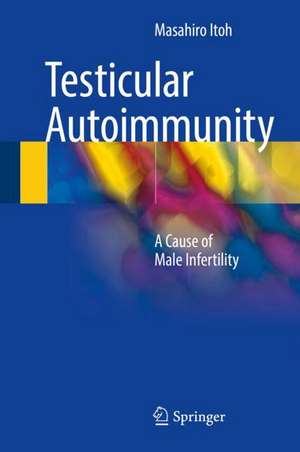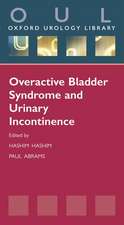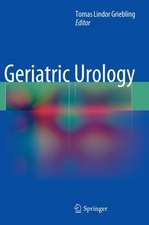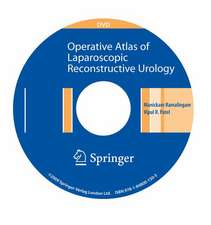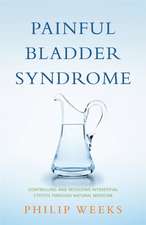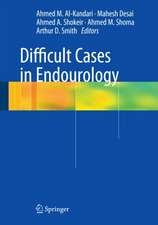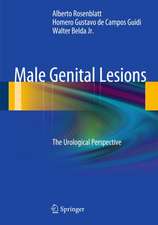Testicular Autoimmunity: A Cause of Male Infertility
Autor Masahiro Itohen Limba Engleză Hardback – 13 aug 2017
This book addresses various aspects of testicular autoimmunity. It has long been suspected that testicular autoimmunity could be one of the causes of idiopathic male infertility. However, it is very difficult to estimate the incidence of testicular autoimmunity in men, as most male patients first realize they are infertile when they start trying to conceive a child, and there is a possibility that their testes may already exhibit the end stage of testicular autoimmunity, in which lymphocytic inflammation and immunoglobulin deposition in their testes subsided long ago and only the spermatogenic disorder remains. Therefore, autopsy or biopsy for testicular tissues in men before the end stage of testicular autoimmunity and investigations using testicular autoimmunity model animals are needed to determine the epidemiology of testicular autoimmunity.
Accordingly, the book discusses “the immunological fragility of testis” with regard to male infertility, re
In summary, the book provides a wealth of valuable information, not only for researchers who are interested in immunologic male infertility, but also for clinical professionals who treat these patients at hospitals.
| Toate formatele și edițiile | Preț | Express |
|---|---|---|
| Paperback (1) | 902.87 lei 39-44 zile | |
| Springer – 14 aug 2018 | 902.87 lei 39-44 zile | |
| Hardback (1) | 906.18 lei 39-44 zile | |
| Springer – 13 aug 2017 | 906.18 lei 39-44 zile |
Preț: 906.18 lei
Preț vechi: 953.87 lei
-5% Nou
Puncte Express: 1359
Preț estimativ în valută:
173.40€ • 185.42$ • 144.58£
173.40€ • 185.42$ • 144.58£
Carte tipărită la comandă
Livrare economică 14-19 aprilie
Preluare comenzi: 021 569.72.76
Specificații
ISBN-13: 9784431544593
ISBN-10: 4431544593
Pagini: 300
Ilustrații: XVII, 232 p. 54 illus., 43 illus. in color.
Dimensiuni: 155 x 235 x 16 mm
Greutate: 0.57 kg
Ediția:1st ed. 2017
Editura: Springer
Colecția Springer
Locul publicării:Tokyo, Japan
ISBN-10: 4431544593
Pagini: 300
Ilustrații: XVII, 232 p. 54 illus., 43 illus. in color.
Dimensiuni: 155 x 235 x 16 mm
Greutate: 0.57 kg
Ediția:1st ed. 2017
Editura: Springer
Colecția Springer
Locul publicării:Tokyo, Japan
Public țintă
Professional/practitionerCuprins
Chapter 1 Biological background of testicular autoimmunity.-
Chapter 2 Microcircumstance for induction and prevention of testicular autoimmunity.-
Chapter 3 Human testicular autoimmunity as a result of breakdown of testicular immune privilege.-
Chapter 4 Testicular autoimmunity by immunization with testicular antigens alone in experimental animals.-
Chapter 5 Testicular autoimmunity by the systemic treatment with immuno-potentiating agents in experimental animals.- Chapter 6 Testicular autoimmunity by local injury of the testis in experimental animals.-&a
mp;nbsp; Chapter 7 Testicular autoimmunity in experimental animals induced by manipulation of the immune system.-
Chapter 8 The future directions of testicular autoimmunity investigation.
Chapter 2 Microcircumstance for induction and prevention of testicular autoimmunity.-
Chapter 3 Human testicular autoimmunity as a result of breakdown of testicular immune privilege.-
Chapter 4 Testicular autoimmunity by immunization with testicular antigens alone in experimental animals.-
Chapter 5 Testicular autoimmunity by the systemic treatment with immuno-potentiating agents in experimental animals.- Chapter 6 Testicular autoimmunity by local injury of the testis in experimental animals.-&a
mp;nbsp; Chapter 7 Testicular autoimmunity in experimental animals induced by manipulation of the immune system.-
Chapter 8 The future directions of testicular autoimmunity investigation.
Notă biografică
Dr. Masahiro Itoh obtained Ph.D. degree in Division of Medicine, Kagawa University, in 1987. he started his carrier as an assistant professor at Kagawa University, and promoted to full Professor in 2001, at Tokyo Medical University. He is one of the top scientists in Japan and well-known as he succeeded in making new murine models of autoimmune orchitis.
Textul de pe ultima copertă
This book addresses various aspects of testicular autoimmunity. It has long been suspected that testicular autoimmunity could be one of the causes of idiopathic male infertility. However, it is very difficult to estimate the incidence of testicular autoimmunity in men, as most male patients first realize they are infertile when they start trying to conceive a child, and there is a possibility that their testes may already exhibit the end stage of testicular autoimmunity, in which lymphocytic inflammation and immunoglobulin deposition in their testes subsided long ago and only the spermatogenic disorder remains. Therefore, autopsy or biopsy for testicular tissues in men before the end stage of testicular autoimmunity and investigations using testicular autoimmunity model animals are needed to determine the epidemiology of testicular autoimmunity.
opsy data in men and presenting experimental data using murine models of autoimmune orchitis that has been induced by immunizing with viable syngeneic testicular germ cells alone. Testicular autoimmunity in animals is also discussed.
Accordingly, the book discusses “the immunological fragility of testis” with regard to male infertility, reviewing aut
In summary, the book provides a wealth of valuable information, not only for researchers who are interested in immunologic male infertility, but also for clinical professionals who treat these patients at hospitals.
Caracteristici
Addresses various aspects of testicular autoimmunity, from its biological background to recent research data
Covers not only the autopsy and biopsy data for humans, but also experimental data using model animals
Written by one of the most prominent researchers in this field, who has established new murine models of autoimmune orchitis
Includes supplementary material: sn.pub/extras
Covers not only the autopsy and biopsy data for humans, but also experimental data using model animals
Written by one of the most prominent researchers in this field, who has established new murine models of autoimmune orchitis
Includes supplementary material: sn.pub/extras
